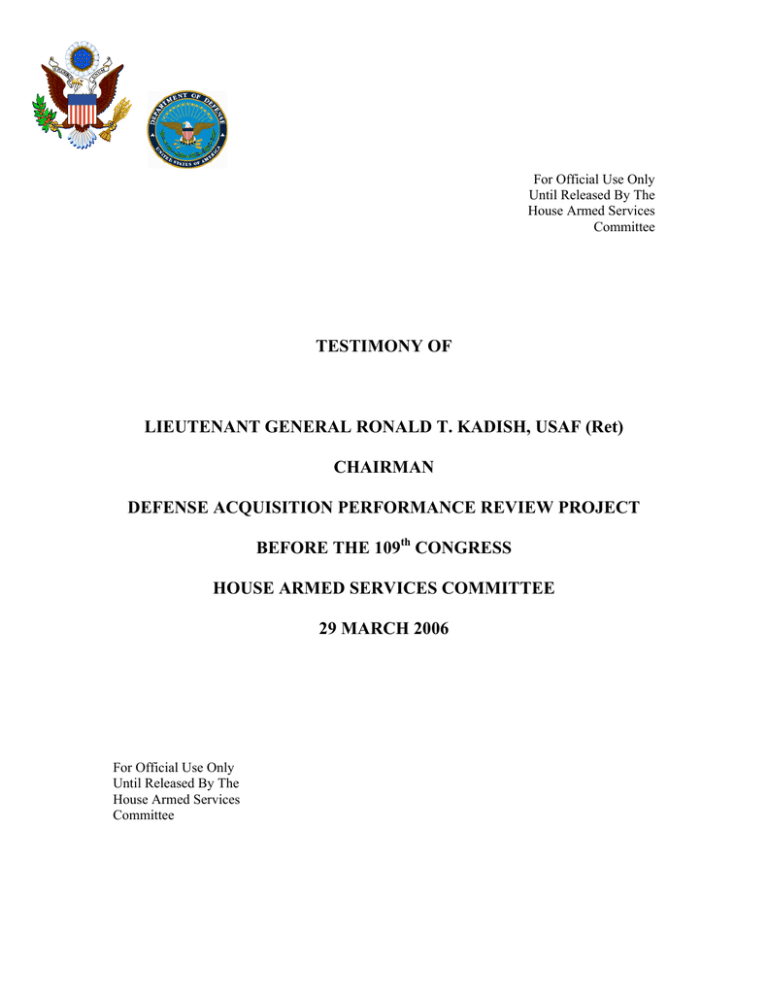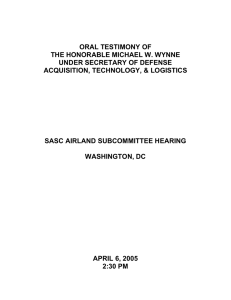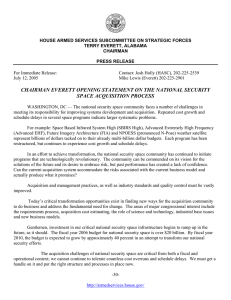TESTIMONY OF LIEUTENANT GENERAL RONALD T. KADISH, USAF (Ret) CHAIRMAN
advertisement

For Official Use Only Until Released By The House Armed Services Committee TESTIMONY OF LIEUTENANT GENERAL RONALD T. KADISH, USAF (Ret) CHAIRMAN DEFENSE ACQUISITION PERFORMANCE REVIEW PROJECT BEFORE THE 109th CONGRESS HOUSE ARMED SERVICES COMMITTEE 29 MARCH 2006 For Official Use Only Until Released By The House Armed Services Committee The Defense Acquisition Performance Review Project Lieutenant General Ronald T. Kadish, USAF (Ret) Chairman Hunter, Representative Skeleton and distinguished members of the Committee: Thank you for the opportunity to appear before you today as the Chairman of the Defense Acquisition Performance Assessment (DAPA), in accordance with the Federal Advisory Committee Act (FACA) of 1972 (Public Law 92-463), to outline the assessments and findings of the DAPA Panel and to provide an independent perspective on the issues. The Panel’s review process was held as open and transparent as possible to engage the public while gathering as much input as practical from all practitioners and stakeholders in DOD’s acquisition process. This initiative was established by then Acting Deputy Secretary of Defense Gordon England in a June 7, 2005 Memo. He directed “an integrated acquisition assessment to consider every aspect of acquisition, including requirements, organizational, legal foundations, decision methodology, oversight, checks and balances – every aspect.” The Deputy Secretary requested that the results be “a 2 recommended acquisition structure and process with clear alignment of responsibility, authority and accountability.” Our findings were reported to the Deputy Secretary in November 2005 and a final report was released in January 2006. Our conclusions cover a broad scope of recommendations. We determined that problems are deeply imbedded in many DoD management systems – not just acquisition. Also, a new approach to improvements is needed to adapt to new security challenges. We reviewed over 1,500 documents to establish a baseline of previous recommendations; we held open meetings and maintained a website to solicit comments from the public. We heard from over 107 experts and received over 170 hours of briefings. Over 130 government and industry acquisition professionals, as well as organized labor union executives, were interviewed. From all of this, we developed over a thousand observations. This then binned down to forty-two areas of interest and we concentrated on the six major elements of the Acquisition System. They are Organization, Workforce, Budget, Requirements, Acquisition and Industry. Historically, numerous studies and reform initiatives have occurred over the years but, it still remains plagued by numerous and highly publicized shortfalls in efficiency. For example, twenty years ago, the President’s Blue Ribbon Commission on Defense (most commonly known 3 as the Packard Commission) ushered in an era of acquisition reform with its finding that DOD’s “weapon systems take too long and cost too much to produce.” Two decades later, many believe major weapon systems Programs “still cost too much and take too long to field.” This committee and others have asked a key question – why? The existing system, however flawed, has produced the most capable, best equipped, and most effective military in the history of the world. We have met the effectiveness test in the past, now we must adapt to a different security environment. Fundamental structural changes in the Acquisition System are needed to adapt to our current security environment. An effective system requires stability and continuity that can only be achieved through integration of all of the major process and elements upon which it depends. Incremental change to the acquisition process alone usually assumes that the other key processes are cohesive and stable. In reality they are disconnected and unstable. I am convinced the sheer complexity of the system is a major impediment and contributes to much confusion about the acquisition processes. Let me explain. There are three fundamental processes the DOD operates. I will refer to these as the big “A” Acquisition System. It includes the requirements process, the planning programming and budget process and 4 the acquisition process. I will refer to the acquisition process alone as “little a” because it is embedded in the big “A” System. Simply focusing on improvements to the “little a” acquisition portion, instead of the larger Acquisition System, can not and will not substantially improve Defense Acquisition Performance. The larger Acquisition System was designed and optimized to respond to a security environment dominated by a single strategic threat, the former Soviet Union. The security environment is very different today --- therefore, the processes need to meet the demands of this environment. We must have the flexibility and agility to respond to more dynamic security environments and rapidly changing needs. Adapting the Acquisition System to the realities of a new security environment cannot be considered independently of the organizations charged with its conduct and the system used to recruit, train, develop and retain its workforce. The “little a” acquisition workforce has been downsized and reorganized over the past 10 years resulting in significant loss of experience. To make up for this loss it appears we’ve imposed even more regulatory approaches to oversight and introduced strategies that insert industry to replace government with many unintended consequences. Key functions of the “big A” Acquisition System, such as requirements development, system engineering, operational testing and transitioning of 5 science and technology, are being pursued as separate almost independent entities adding to the cost and complexity process. Finally, the industrial environment has changed in fundamental ways. Globalization and industry consolidation over the last 15 years, as well as our “outsourcing” policies affect the processes and strategies and techniques that we use and are required to be used. This raises many key questions. Does competition produce desired outcomes? Can we accommodate globalization? Why don’t non-traditional suppliers compete for defense business? Our process for this project was much disciplined and we sought to validate all of the assessments, improvements, and major findings and finally, identify time-specific implementation plans. I will highlight the some of recommendations to improve stability in the Acquisition system that the Panel has provided to the Deputy Secretary: Organization • Realign authority, accountability and responsibility at the appropriate levels. • Enhance the stature of the Under Secretary of Defense for Acquisition, Technology and Logistics and have the USD/AT&L become a voting member of the Joint Requirements Oversight Committee. 6 • Establish a Four-Star Acquisition Systems Commands to include oversight of the entire spectrum of the acquisition community -workforce, contracts, requirements, science and technology, budget and program integration. Workforce • Rebuild value and stabilize the leadership in the acquisition workforce and establish a consistent definition of this function. • Seek legislation to establish Senior Acquisition Executives as fiveyear fixed terms renewable for a second five-year term. • Enhance the training education, certification and qualifications for the entire acquisition workforce. Budget • Enhance Planning, Programming, and Budgeting and execution system by programming to high confidence estimates to avoid the “conspiracy of hope.” • Establish a distinct Stable Funding Program Account based on Capital Budgeting at milestone A. Requirements • Replace the Joint Capabilities Integration and Development System with a Joint Capabilities Acquisition and Divestment Plan. 7 • Require Combatant Commanders to prepared extended planning annexes and forecast gaps and excesses. • Require Time Certain Development as a Key Performance Parameter. • Require DDR&E to coordinate science and technology plans and technology push initiatives. • Seek legislation to create an “Operationally Acceptable.” evaluation testing category. Acquisition • Adopt a risk-based source selection process. • Shift to time-certain development. • Make schedule a Key Performance Parameter. • Reposition Milestone B to occur after preliminary design review. Industry • Share long range plans with industry. • Restructure competitions to motivate industry to invest in technology and performance. • Evaluate the impact of industrial consolidation and its unintended effects. • Address the issue of globalization of the defense industry. 8 In conclusion, the DAPA Panel has proposed sweeping changes to dramatically improve the Departments ability to stabilize and integrate key elements of the Acquisition System. Simply focusing on improvements to the “little a” acquisition portion of this system, instead of the larger Acquisition process, can not and will not substantially improve Defense Acquisition Performance. As I have listened in panel meetings and studied this problem over the past few months – and lived in this environment for over 25 years -- I am convinced we can do better. Our collective challenge will then be to overcome the myriad of interests, conflicting policies and incentives and inherent conflicts so that we can exploit technology to support our war fighters as efficiently as practicable. Otherwise we will have another effort in a few years addressing the same issues we have today. We must ensure that in our efforts to improve the system, we do not degrade our existing ability to provide our war fighters with the systems and technologies they need to dominate the battlefield. Thank you for the opportunity to appear before you today. 9






